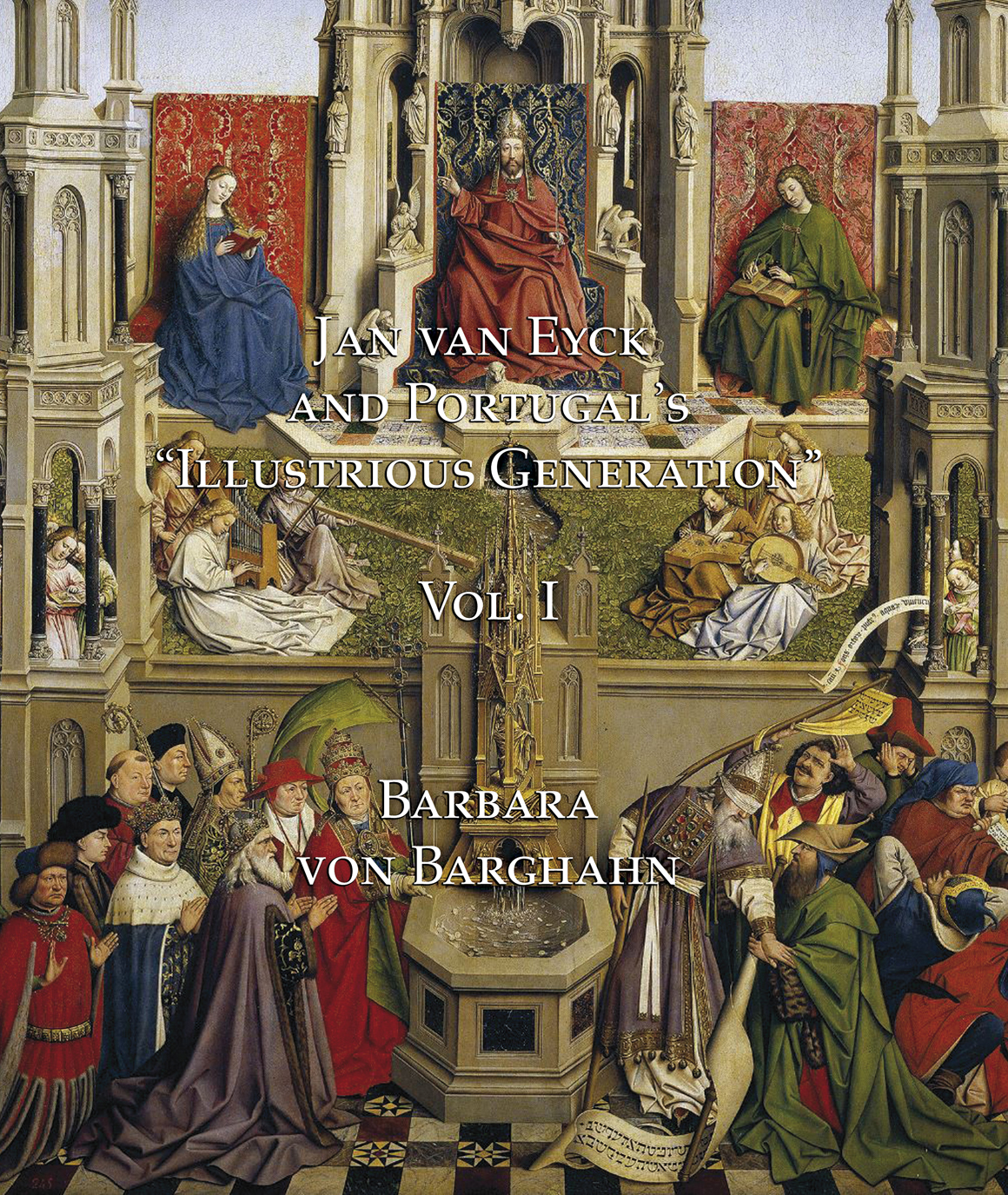Book Description
This book investigates Jan Van Eyck’s patronage by the Crown of Portugal and his role as diplomat-painter for the Duchy of Burgundy following his first voyage to Lisbon in 1428-1429, when he painted two portraits of Infanta Isabella, who became the third wife of Philip the Good in 1430. New portrait identifications are provided for the Ghent Altarpiece (1432) and its iconographical prototype, the lost Fountain of Life. These altarpieces are analysed with regard to King João I’s conquest of Ceuta, achieved by his sons, who were hailed as an “illustrious generation.” Strong family ties between the dynastic houses of Avis and Lancaster explain Lusitania’s sustained fascination with Arthurian lore and the Grail quest.
Several chapters of this book are overlaid with a chivalric veneer. A second “secret mission” to Portugal in 1437 by Jan van Eyck is postulated and this diplomatic visit is related to Prince Henry the Navigator’s expedition to Tangier and King Duarte’s attempts to forge an alliance with Alfonso V of Aragon. Late Eyckian commissions are reviewed in the light of this ill-fated crusade and additional new portraits are identified. The most significant artist of Renaissance Flanders appears to have been patronized as much by the House of Avis as by the Duchy of Burgundy.
Barbara von Barghahn is Professor of Art History at George Washington University and a specialist in the art history of Portugal, Spain, and their colonial dominions, as well as Flanders. In 1993, she was conferred O Grão Comendador in the Portuguese Order of Prince Henry the Navigator. She has spent nearly a decade completing research about Jan van Eyck’s diplomatic visits to the Iberian Peninsula.
Contents
- Preface
- Introduction: Jan Van Eyck Circa 1425-1427; Historical Prologue: The Hague and Flanders; Jan van Eyck’s 1425-1426 “Secret Journey”; The 1427 “Secret Voyage” To Aragon
- The 1428-1429 “Secret Voyage” to Portugal; A Mission on Behalf of the Duke of Burgundy; Polemical Portraits of the Infanta ; Jan’s Grand Tour: Lisbon to Porto; Houses of Guimarães and Braga’s Monte Espinho; Parenthetical Thoughts about Jan van Eyck’s Diplomatic Excursions
The Fountain Of Life (1429) and the Avis Dynastic House; Portraits of King João I and Lusitania’s Princes; The Wing Panels of the Fountain of Life: ; Jan van Eyck’s Diptych of the Crucifixion and the Last Judgment ; The Chivalric Orders and the Defense of the Faith; The Portuguese Elevation of Charlemagne; Reflections upon the New Jerusalem - The Lisbon of King João I and Sintra, The “Queen’s Estate”; The Monarch’s Palaces in Lisbon; The St. Martin Palace of Prince Duarte; Prince Henrique’s Houses near St. Vincent Behind the Walls ; Prince Pedro’s Estaus Palace; The Houses of Princes João and Fernando; The Residence of Count-Duke Afonso; The Avis-Lancastrian Palace of Sintra: Templar and Arthurian Ideals; The “Swan Hall” or Sala dos Infantes; The “Magpie Hall” and Alchemical Emblems; A Royal Chapel for Crusader Knights: Pageants and the Complexion of Society ; The Winds of Pentecostal Spirit: Sintra’s Royal Apartments
- Isabel of Portugal and the Lion of Flanders; Departure from Portugal: An Infanta’s Reception in Flanders; Festivities in Bruges; 1430 and the Brabantine Inheritance of Philip the Good; A “House of Marvels” in Artois: Hesdin and Jan van Eyck’s “Ducal Hunts” ; The Versailles Hunting Party; Thoughts about Poetry and Music
- The Ghent Altarpiece (1432); Medieval Ghent: A City of Political Islands; Philip the Good’s Castles at Ghent; Sint-Janskerk and its Patrons: The Ghent Altarpiece and its Specters; The Exterior Panels of the Ghent Altarpiece; A “Tabernacle of God” with Man; Windows unto Ghent
The Grail Quest & Chivalric Ideals: Counts Of Flanders & Paladins Of Lusitania; Throne for the “Dayspring on High”: Adoration of the Lamb; The Tree of Knowledge; Cavalcade of Just Judges; Cavalcade of Holy Knights: Princes of Ceuta; In the Company of Royal Warriors; Holy Hermits and Pilgrims; Imitating the Heroes of Camelot; The Cistercian Ideal of the Grail Knight in Portugal - Circa 1437: Jan Van Eyck’s “Secret Mission” To Portugal ; The Templar Citadel of Tomar: Romanesque unto Renaissance; King João I’s Batalha Abbey 1429-1450; St. Barbara with her Tower: Batalha’s Capelas Imperfeitas and a View of Lisbon; Tangier and the Sword of St. Catherine: The Dresden Triptych ; A Setting for an Ex-Voto Triptych: The Chapel of St. Michael in the Lisbon; Castle of St. George
- “Our Lady’s Knights” & The House Of Avis; Prince Henrique the Navigator, the Moroccan Campaign & Franciscan Spirituality ; Prince Pedro, the Kingdom of Aragon and St. George the Dragon Slayer; Crucible of Wisdom: King Duarte and the Diptych of the Madonna in a Church; The Lisbon Cathedral of Santa Maria and the Chapel of St. Vincent
- Miscellanea: Reflections Within a Dark Glass ; A Lost Triptych and the Lomellini of Lisbon and Madeira; Philip the Good’s Mappamundi; The Ghent “Hell” Altar Frontal & the Passion Panels of Lodewijk Allyncbrood ; A Portuguese Disciple of Jan van Eyck in Bruges ; Holy Kinship, Holy Face: Imaging an Icon for the Avis Court ; Ecclesia-Eleousa and a Metaphorical “Cloth of Honor”: Magnifying Feminine Virtú
- Conclusion: Ecclesia and an Age of Crusaders; Shield, Spurs and Sword for La Sainte-Église: Revisiting the Theme of the Grail Banquet; and Knightly Entrêmets; The 1454 “Feast of the Pheasant” marking the Birthday of Duchess Isabel of Burgundy; In the Company of St. Thekla: A Last Glimpse of the Portuguese Infanta
- Index
See also:
Volume II





Reviews
There are no reviews yet.